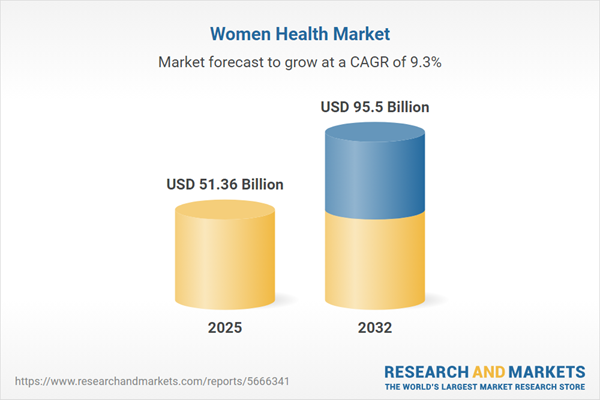Speak directly to the analyst to clarify any post sales queries you may have.
The women’s health market is evolving rapidly as digital technologies and new care models reshape industry standards. Senior decision-makers face a dynamic landscape that demands targeted market intelligence for informed strategic planning and competitive positioning.
Women’s Health Market Snapshot
The global women’s health market reached USD 46.99 billion in 2024 and is projected to attain USD 51.36 billion by 2025. Long-term expectations see the market expanding to USD 95.50 billion by 2032, reflecting a robust compound annual growth rate (CAGR) of 9.26%. This growth is shaped by widespread adoption of personalized healthcare solutions, increasing use of digital care platforms, and forward-thinking policies that improve accessibility. Businesses are adjusting by developing flexible service models, utilizing technology to address diverse health needs, and focusing on individualized offerings. Progress in consumer preferences and a supportive regulatory environment continue to define new opportunities for market engagement and sustainable growth.
Scope & Segmentation of the Women’s Health Market
This report offers actionable insights for leadership, defining strategic priorities and clarifying the evolving risk landscape across key domains:
- Product Segments: Medical devices (notably contraceptives and diagnostics), pharmaceuticals targeting fertility and hormonal management, and nutraceuticals designed for prenatal, postnatal, and bone health all represent active opportunity areas.
- Distribution Channels: Traditional and digital pharmacies, e-commerce portals, direct-to-consumer models, and subscription-based services enable enhanced access to care and recurring engagement.
- Applications: Solutions span fertility management, reproductive and gynecological care, hormonal and menstrual health, as well as holistic wellness programs reflecting evolving patient demands.
- End Users: Hospitals and clinics, alongside patients increasingly utilizing telehealth and digital care tools, highlight the expanding need for flexible, technology-driven support options.
- Regional Coverage: Americas, Europe, Middle East & Africa, and Asia-Pacific, each operating under region-specific policies, digital maturity levels, and reimbursement frameworks shaping local market potential.
- Key Companies Profiled: Bayer AG, Pfizer Inc., Merck & Co., Ferring International Center S.A., Teva Pharmaceutical Industries Ltd., Organon & Co., AbbVie Inc., Novartis AG, Roche Holding AG, and Amgen Inc. are featured as leading market participants.
Key Takeaways for Senior Decision-Makers
- Digital health solutions are enabling more direct patient engagement, making strategic investment in agile digital infrastructure essential for long-term relevance.
- Personalized care approaches and increased digitization are transforming data usage and improving supply chain agility to fulfill patient-centric demands.
- Collaboration across stakeholders and a disciplined approach to innovation foster market adaptability and help leaders recognize new business prospects.
- Adaptive compliance strategies are critical, especially as regulatory policies introduce decentralized clinical trials and increased oversight requirements for women’s health products.
- Customizing business models by region, with attention to variable technology adoption and reimbursement structures, supports operational efficiency and improved market fit.
Tariff Impact: United States Trade Measures
In 2025, new tariff measures in the United States are increasing costs for manufacturers and suppliers in women’s health medical devices, pharmaceuticals, and nutraceuticals. Organizations are responding by strengthening domestic production, expanding supplier networks, and optimizing supply chain practices. Proactive attention to compliance and procurement processes supports effective risk management and business continuity during evolving tariff conditions.
Women’s Health Market Research Methodology & Data Sources
Insights presented in this report are grounded in validated data, comprehensive secondary research, and scenario-based forecasting. The methodology ensures current, reliable analysis aligned with industry and regulatory standards to support confident decision-making by senior leaders.
Why This Women’s Health Market Report Matters
- This report helps senior executives act decisively in response to technology shifts, changing patient expectations, and complex regulatory conditions.
- Clear segmentation and opportunity identification ensure investments and resources are allocated optimally across business areas.
- Risk-focused analysis and competitor insights enable proactive mitigation and enhance confidence in complex or uncertain market conditions.
Conclusion
This report delivers executive-level market intelligence, supporting the alignment of strategic objectives and long-term sustainable growth as the women’s health sector continues its transformation.
Additional Product Information:
- Purchase of this report includes 1 year online access with quarterly updates.
- This report can be updated on request. Please contact our Customer Experience team using the Ask a Question widget on our website.
Table of Contents
3. Executive Summary
4. Market Overview
7. Cumulative Impact of Artificial Intelligence 2025
Companies Mentioned
The companies profiled in this Women's Health market report include:- Bayer AG
- Pfizer Inc.
- Merck & Co., Inc.
- Ferring International Center S.A.
- Teva Pharmaceutical Industries Ltd.
- Organon & Co.
- AbbVie Inc.
- Novartis AG
- Roche Holding AG
- Amgen Inc.
Table Information
| Report Attribute | Details |
|---|---|
| No. of Pages | 185 |
| Published | November 2025 |
| Forecast Period | 2025 - 2032 |
| Estimated Market Value ( USD | $ 51.36 Billion |
| Forecasted Market Value ( USD | $ 95.5 Billion |
| Compound Annual Growth Rate | 9.2% |
| Regions Covered | Global |
| No. of Companies Mentioned | 11 |









